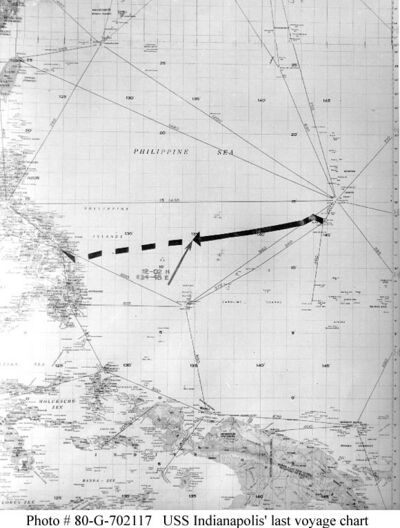USS Indianapolis (CA-35): Difference between revisions
imported>Howard C. Berkowitz No edit summary |
mNo edit summary |
||
| (2 intermediate revisions by 2 users not shown) | |||
| Line 1: | Line 1: | ||
{{subpages}} | {{PropDel}}<br><br>{{subpages}} | ||
{{TOC|right}} | {{TOC|right}} | ||
[[Image:CA-35 Indianapolis in 1937.jpg|left|thumb|350px|''USS Indianapolis'' at Pearl Harbor in 1937]] | [[Image:CA-35 Indianapolis in 1937.jpg|left|thumb|350px|''USS Indianapolis'' at Pearl Harbor in 1937]] | ||
| Line 15: | Line 15: | ||
==Role in nuclear attacks== | ==Role in nuclear attacks== | ||
==Loss== | ==Loss== | ||
[[Image:CA-35 last voyage.jpg|right|thumb|400px|Last voyage of the ''Indianapolis''; dashed line shows projected course after her sinking]] | |||
==References== | ==References== | ||
{{reflist}} | {{reflist}} | ||
[[Category:Suggestion Bot Tag]] | |||
Latest revision as of 16:00, 1 November 2024
| This article may be deleted soon. | ||
|---|---|---|
USS Indianapolis (CA-35) was a Portland-class heavy cruiser of the United States Navy, entering service in 1932, and accumulating a distinguished record before being sunk in what would be the worst single-ship loss of life in the history of the Navy. Before the war, she sailed with President Franklin D. Roosevelt, and, during the war, would be the flagship of Admiral Raymond Spruance and the United States Fifth Fleet. The shipShe was a member of a two-ship class derived from the Northampton-class cruisers built under the limitations of the Washington Naval Treaty. The derivation came when concerns were raised about the protection of the Northamptons, and designers realized that the as-built ships, under the Treaty, could have protection improved without exceeding the 10,000 ton limit. The subsequent New Orleans-class was markedly superior, but the Portland and Indianapolis were too far along in construction to be upgraded. They came in at 9800 tons.[1] Pre-WWIIEarly serviceFifth FleetRole in nuclear attacksLossReferences
|
||

